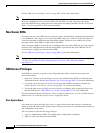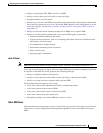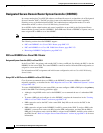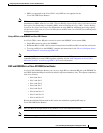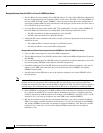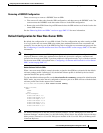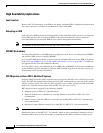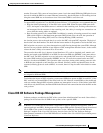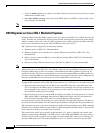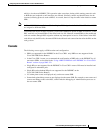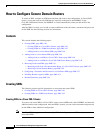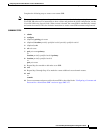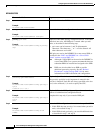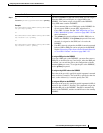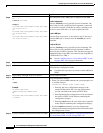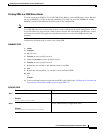
Configuring Secure Domain Routers on Cisco IOS XR Software
Information About Configuring Secure Domain Routers
SMC-138
Cisco IOS XR System Management Configuration Guide
• To access install commands, you must be a member of the root-system user group with access to the
Administration EXEC mode.
• Most show install commands can be used in the EXEC mode of an SDR to view the details of the
active packages for that SDR.
Note For information, see Default Configuration for New Non-Owner SDRs, page SMC-135
DSC Migration on Cisco CRS-1 Multishelf Systems
Designated Shelf Controller (DSC) migration is the act of moving the DSC role to a different part of the
router. The DSC role automatically migrates when the DSC cannot perform its function on the shelf in
which it currently resides. The cause of a DSC migration can be a failure of both of the RPs in the DSC
shelf or any event that removes power from the DSC line card chassis (LCC).
DSC migration can be triggered by the following methods:
1. Shutdown power to DSC LCC. (Recommended)
2. Hardware-module reset or shutdown of a standby RP then an active RP in a DSC LCC. (Not
recommended)
3. Online, insertion, removal (OIR) for an active RP and standby RP in a DSC LCC simultaneously.
(Not recommended)
4. Removal of control Ethernet connectivity to both RPs in a DSC LCC. (Not recommended)
Note If planned downtime of a DSC LCC occurs, the recommended method of triggering DSC migration is to
shutdown the power to the DSC LCC. The methods, which are not recommended, shutdown only one
transport medium in the system. For example, control Ethernet but fabric medium can still be up for
another 30 seconds. This causes an inconsistent system view in the named SDR using DRP paired across
the rack in which the DRP loses control Ethernet connectivity, but the LR plane is still working and can
bring the named SDR into an inconsistent view if the named SDR is across the rack.
To support DSC migration in Cisco IOS XR Software Release 3.3.2 and higher, we recommend that you:
• Keep the default placement of all four RPs in the owner SDR. When the owner SDR spans both
LCCs, the impact on the SDR resources is minimal in the remaining rack. Existing connections are
not interrupted for the resources in the remaining rack, but a delay in routing new connections can
occur while the routing tables are updated.
• Run all routing protocols in a named SDR. In addition, by running all routing protocols in a named
SDR, which requires a distributed route processor (DRP) paired across the rack, the operation of
Cisco Nonstop Forwarding (NSF) and Cisco Nonstop Routing (NSR) continues.
An election process selects the node that is to receive the DSC role upon DSC migration. The basis of
the election is the shelf number. The shelf with the lowest number is designated to receive the DSC role.
DSC migration can cause a very short interruption to traffic flowing through the owner SDR. Although
the time can vary with the addition of new features to DSC management and other factors, in the current
release the time is likely to be around 20 to 30 seconds.
The reason for the traffic loss is because virtual Interfaces (VI), such as loopback, null, tunnels, and
bundles are hosted on the DSDRSC of an SDR. For the owner SDR, the DSDRSC is the same node as
the DSC itself. For DSC migration to occur, both active and standby DSC must be lost. Therefore, for
the owner SDR, both active and standby DSDRSC are lost. VI's must be recreated on the new DSC,



